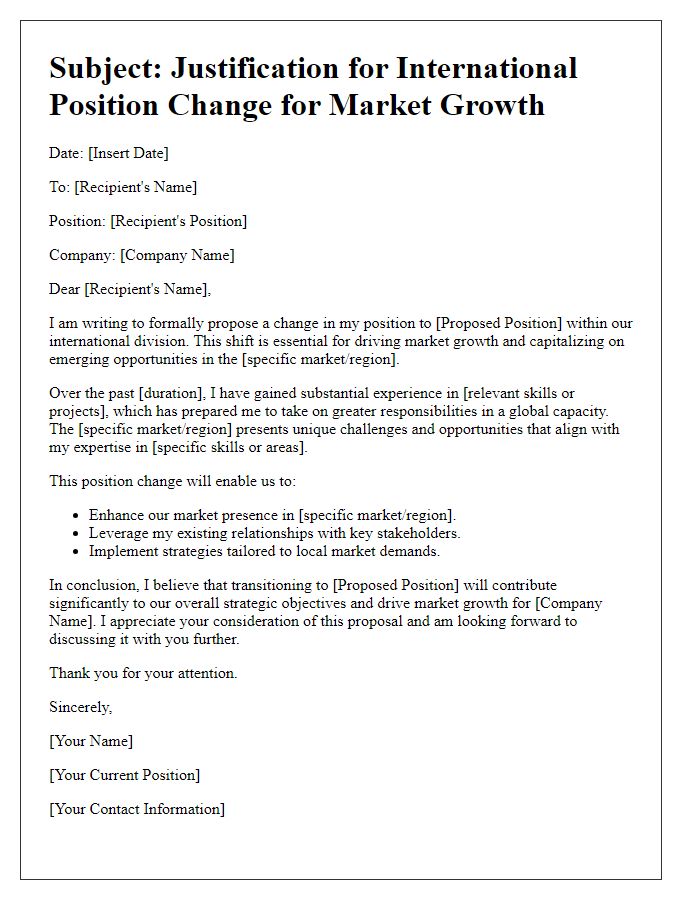Are you considering expanding your horizons with an international position transfer? Crafting the perfect letter can set the tone for this exciting opportunity, showcasing your professional skills while expressing your desire for growth within the company. It's essential to highlight your adaptability and eagerness to embrace new challenges in a different setting. Curious to learn how to structure your application effectively? Read on for a detailed guide!

Professional Salutation
International job transfers can provide employees with new career opportunities and cultural experiences. A clear outline of the desired position, such as a Project Manager role at a multinational company, can emphasize specific responsibilities, including team leadership, budget management, and stakeholder communication across global offices. Job requirements may include fluency in multiple languages, adaptability to varying work environments, and strong interpersonal skills to engage with diverse teams. An understanding of the new location's business practices and legal frameworks is critical for a smooth transition, ensuring compliance with local regulations while maintaining organizational standards.
Introduction and Current Position
An application for an international position transfer often begins with a concise introduction that highlights the applicant's current role and the organization they represent. For example, an employee working as a Senior Marketing Manager at a global company like Acme Corp in New York City may state their tenure, showcasing their experience with various successful campaigns that increased brand visibility by 30% over the last fiscal year. This introduction sets the stage for explaining the desire to transition to an international office, such as the branch in London, to leverage skills in a diverse market while contributing to the company's global mission.
Reason for Transfer Request
Transferring to a global position can significantly enhance personal and professional growth, especially in multinational companies. The opportunity to work in cities like London, New York, or Tokyo allows for immersion in diverse cultures and innovation. Engaging with international teams can foster collaboration and a broader understanding of global markets. Additionally, adapting to varying work environments expands skill sets, making employees more versatile. Motivations behind this request include career advancement, broader exposure to industry practices, and the prospect of contributing to high-impact projects that align with the company's strategic goals.
Skills and Contributions
Applying for an international position transfer requires a clear demonstration of skills and contributions in a specific context. Outstanding communication abilities enhance collaboration across diverse teams, boosting overall productivity. Proficiency in foreign languages, such as Spanish or Mandarin, allows for effective engagement with international clients, fostering strong business relationships. In previous roles, leading projects, like the 2022 Market Expansion Initiative, resulted in a 30% increase in revenue in the Asia-Pacific region. Cultural awareness and adaptability, vital in global operations, facilitate seamless integration into new environments, reducing transition periods. Experience with cross-functional training programs supports knowledge sharing and empowers teams, ensuring sustained performance enhancements.
Closing Remarks and Contact Information
In pursuing an international position transfer, expressing appreciation is vital. Acknowledging the opportunity to apply for a position in a different country fosters a positive impression. Including contact information, such as a professional email address and phone number, facilitates further communication. Highlighting willingness to discuss relocation details or any additional requirements showcases commitment. Reinforcing enthusiasm for the new role and potential contributions to the global team enhances the overall message. A clear, concise closing statement leaves a lasting impression on the hiring manager.
Letter Template For Applying For International Position Transfer Samples
Letter template of request for international position transfer due to personal circumstances.

Letter template of application for international job transfer for career advancement.

Letter template of proposal for international assignment transfer for skills development.

Letter template of inquiry for international position transition for family reasons.

Letter template of appeal for relocation to an international office for team collaboration.

Letter template of justification for international position change for market growth.

Letter template of application for overseas transfer to enhance global exposure.

Letter template of recommendation for international position reassignment.

Letter template of notification for intent to transfer to an international position.





Comments